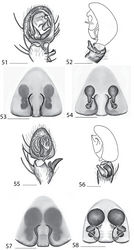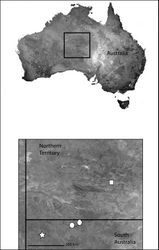Karaops pilkingtoni
| Notice: | This page is derived from the original publication listed below, whose author(s) should always be credited. Further contributors may edit and improve the content of this page and, consequently, need to be credited as well (see page history). Any assessment of factual correctness requires a careful review of the original article as well as of subsequent contributions.
If you are uncertain whether your planned contribution is correct or not, we suggest that you use the associated discussion page instead of editing the page directly. This page should be cited as follows (rationale):
Citation formats to copy and paste
BibTeX: @article{Crews2011ZooKeys99, RIS/ Endnote: TY - JOUR Wikipedia/ Citizendium: <ref name="Crews2011ZooKeys99">{{Citation See also the citation download page at the journal. |
Ordo: Araneae
Familia: Selenopidae
Genus: Karaops
Name
Karaops pilkingtoni Crews & Harvey, 2011 sp. n. – Wikispecies link – ZooBank link – Pensoft Profile
Type material
Holotype male (WAM T76590): base of Trig Hill, Old Telegraph Station, Alice Springs, Northern Territory, Australia, 23°40'S, 134°14'E, 3.V.1986, B.J. Scott, under rocks. Paratype. Alice Springs, Grid reference 2741.1000, 1:250,000 sheet [23°16'15"S, 134°52'50"E], 25.VI.1978, F. and J. Aslin, 1♀ (SAM N199359).
Etymology
This species is named in honor of Karl Pilkington.
Diagnosis
The male has a thick and short embolus that bisects the bulb (Fig. 55). The female has a wrinkled median septum and huge, round spermathecae that almost touch medially (Figs 57–58).
Description
Male (holotype):Color: carapace uniformly yellow-brown; sternum pale yellow-brown; chelicerae pale yellow with darker infuscations anteriorly; maxillae pale yellow-brown; labium pale brown; abdomen dorsally yellow-brown with red-brown markings; ventrally pale yellow-brown; legs with all segments clearly annulated. Cephalothorax:setae short, stout, rodlike; 0.92 times longer than broad; fovea longitudinal, broad, very shallow. Eyes:AER nearly straight; PER recurved; PME larger than AME, PLE largest, ALE smallest; eye group width 1.21; eye diameters, AME 0.16, ALE 0.07, PME 0.20, PLE 0.23; interdistances AME-ALE 0.19, PME-PLE 0.17, ALE-PLE 0.25, AME-PME 0.03; ocular quadrangle AME-AME 0.42, PME-PME 0.66; clypeus 0.09 high. Mouthparts:chelicerae with a few stout setae medially and anteriorly; lateral boss present, smooth; promargin with 3 teeth, retromargin with 2 teeth; maxillae longer than broad, with tuft of conspicuous setae distally; labium distally rounded. Sternum:0.81 times longer than broad, posteriorly indented. Pedipalp:femur, spination dorsal 0–1–1; retrolateral tibial apophysis with 2 processes, dorsal apophysis directed laterally, blade like in ventral view, ventral apophysis flattened at tip; retrolateral basal cymbial process present; cymbial scopulae absent, cymbium triangular, conductor pointed, blade like; embolus short and stout, beginning at 6 o’clock, directed distally through center of bulb, toward 12 o’clock; MA long, with a wide base that tapers to a small hook, directed distally (Figs 55–56). Legs:leg I only slightly shorter than legs II, III and IV; leg formula unknown (at least one leg missing); scopulae absent on all legs; tarsi with strong claw tufts; claws without teeth; spination: leg I, Fm pr 1–1–0, d 1–1–1, rl 0; Ti d 0, v 2–2–2–2–2; Mt v 2–2–2; Ti and Mt I and II with strong spines; leg II, Fm pr 0, d 1–1–1, rl 0–1–1; Ti v 2–2–2–2–2; Mt v 2–2–2; leg III, Fm pr 0, d 1–1–1, rl 0–1–1; Ti 0; Mt 0; leg IV, F pr 0, d 1–1–1, rl 0; Ti 0; Mt 0. Abdomen:terminal setal tufts present. Dimensions: Total length 3.89. Cephalothorax length 2.31, width 2.51. Sternum length 1.13, width 1.39. Abdomen length 1.59, width 1.79. Pedipalp: Fm 0.65, Pt 0.55, Ti 0.29, Ta 0.65, (total) 2.14. Leg II: Missing. Leg III: Fm 4.52, Pt 1.22, Ti 3.88, Mt 3.36, Ta 1.38, (total) 14.36. Leg IV: Fm 4.32, Pt 1.15, Ti 3.51, Mt 3.27, Ta 1.55, (total) 13.80.
Female (paratype):Color: carapace yellow-brown, with slightly darker marks medially; sternum pale yellow-brown; chelicerae pale yellow with darker infuscations anteriorly and laterally; maxillae pale yellow-brown; labium pale brown; abdomen dorsally yellow-brown with red-brown markings; ventrally pale yellow-brown; legs with all segments clearly annulated. Cephalothorax:setae short stout and rodlike; 0.83 times longer than broad; fovea longitudinal, broad, very shallow. Eyes:AER nearly straight; PER slightly recurved; PME larger than AME, PLE largest, ALE smallest; eye group width 1.62; eye diameters, AME 0.20, ALE 0.12, PME 0.25, PLE 0.28; interdistances AME-ALE 0.32, PME-PLE 0.30 ALE-PLE 0.29, AME-PME 0.07; ocular quadrangle AME-AME 0.50, PME-PME 0.92; clypeus 0.16 high. Mouthparts:chelicerae with a few stout setae medially and anteriorly; lateral boss present, smooth; promargin with 3 teeth, retromargin with 2 teeth; maxillae longer than broad, with tuft of conspicuous setae distally; labium distally rounded. Sternum:0.78 times longer than broad, posteriorly indented. Pedipalp:tarsus slightly swollen, claw present, without teeth. Legs:leg I only slightly shorter than legs II, III and IV; leg formula 3241; scopulae absent on all legs; tarsus I–IV with strong claw tufts; claws without teeth; spination: leg I, Fm pr 1–1–0, d 1–1–1, rl 0; Ti d 0, v 2–2–2–2–2; Mt v 2–2–2; Ti and Mt I and II with strong spines; leg II, Fm pr 0, d 1–1–1, rl 0; Ti v 2–2–2–2–2; Mt v 2–2–2–2; leg III, Fm pr 0, d 1–1–1, rl 0; Ti 0; Mt 0; leg IV, Fm pr 0, d 1–1–1, rl 0; Ti 0; Mt 0. Abdomen:possible setal tufts, hairs worn off. Epigyne:lateral lobes separated by slightly wrinkled, unsclerotized, quadrate fleshy median area, copulatory openings located anterolaterally, epigynal pockets absent; internally, small ducts lead to extremely large round spermathecae, fertilization ducts located posteriorly, posterodorsal fold absent (Figs 57–58). Dimensions: Total length 5.25. Cephalothorax length 2.68, width 3.22. Sternum length 1.35, width 1.72. Abdomen length 3.02, width 2.81. Pedipalp: Fm 0.73, Pt 0.60, Ti 0.67, Ta 0.81, (total) 2.81. Leg I: Fm 3.12, Pt 1.35, Ti 2.80, Mt 2.24, Ta 1.08, (total) 10.59. Leg II: Fm 3.96, Pt 1.46, Ti 3.30, Mt 2.65, Ta 1.25, (total) 12.62. Leg III: Fm 4.84, Pt 1.40, Ti 3.54, Mt 2.90, Ta 1.31, (total) 13.99. Leg IV: Fm 4.06, Pt 1.36, Ti 3.12, Mt 2.72, Ta 1.24, (total) 12.50.
Natural history
Collected from under rocks.
Distribution
Only from Alice Springs (Map 9).
Original Description
- Crews, S; Harvey, M; 2011: The spider family Selenopidae (Arachnida, Araneae) in Australasia and the Oriental Region ZooKeys, 99: 1-104. doi
Images
|

